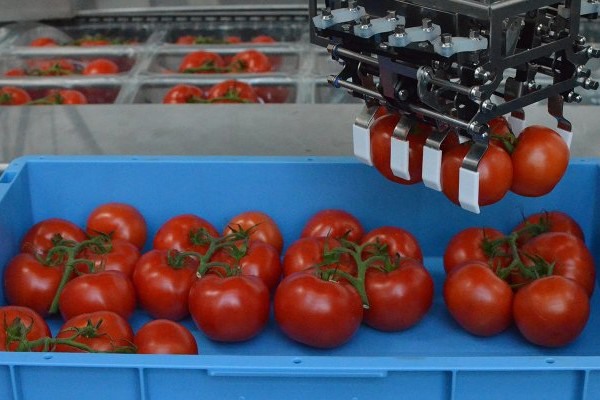Having a bunch of grapes picked and packed by a robot already requires a lot of technology. But it can be even more complicated: automatically preparing a ready-made salad. Researchers from the Wageningen University & Research Agro Food Robotics programme will take up this challenge over the next five years, WUR writes. "The technology is now ripe for it."
Meal salads from the supermarket consist of lettuce, raw vegetables, pasta, potatoes, fruit, nuts, egg, cheese, meat and fish. It is currently not yet possible to collect and package all these different products with one machine without human intervention. Over the next five years, WUR experts in computer vision, robotics and artificial intelligence will change this in cooperation with partners from the business world. And that will save a lot of manpower on the assembly line, which is advantageous in an increasingly tight labour market.

Photo by WUR
Automatic preparation and packaging of a meal salad requires robots to perform all kinds of operations that also take place when packaging individual products. Cameras shoot images for advanced computer programmes, which have to recognise the products. The same software then directs robotic grippers to remove the produce quickly and undamaged from the harvest crates and place it in customised packaging. The packaging is then sealed and printed with the required product information.
Artificial intelligence
The technology that the researchers will now develop further builds on the results from 'Pick'nPack'. This project was led by WUR from 2011 to 2016. "Producers were not immediately queuing up for Pick'nPack technology back then, but that is starting to change," notes Paul Goethals, business development manager of the WUR Agro Food Robotics programme. Not only is the need growing in these times of labour shortages, Goethals says the technology has become more advanced and cheaper. The big difference is in the huge advance of artificial intelligence. "AI is making these kinds of robot applications increasingly interesting for companies," he says.
"First, we had to specify features ourselves to analyse camera images. Now we use machine learning with training data. Based on this, the software itself starts distinguishing characteristics of certain vegetables," Goethals explains. "That helps the robots to recognise and grab the produce already in the harvest crate, without humans having to put them neatly on the conveyor belt first. They are also often fragile products lying on top of each other." This makes it necessary to control the robot very precisely.
Flexible robots
The ultimate goal is a flexible robot. After all, cucumbers are different from grapes. This requires different 'hands' or suction cups that prevent soft fruit from being damaged. If there is a different product in the crate, the aim is to find the right gripper and activate the corresponding computer programme. With an increasing variety of products - think of all types of tomatoes - it saves time, money and labour if a machine can switch quickly. Moreover, different products sometimes go into the same packaging. Goethals: "Even the ingredients for a soup pack, for example, will soon be packaged together in this way."
Goethals and his colleagues use the latest artificial intelligence tools. "A sensor in the gripper is interesting for quality control. This quickly reveals whether there is something wrong with a product. With that information, the robot can automatically sort the products into different quality grades or for a residual stream to be used elsewhere." The data it collects then also makes it easy to trace products back to the grower and print product information on the packaging. Even cleaning of the equipment can be made 'smarter' by using sensors to continuously measure contamination of machines and clean from the inside only where and when needed.
Over the next five years, Agro Food Robotics and industry partners will bring together their previous work and the new developments into one flexible 'state-of-the-art' production robot for meal salads. Subsequently, the new knowledge will also be shared with other companies in the overarching Nxt Gen HighTech programme. "We were ahead of the game with Pick'nPack, but now we can further develop and start applying our prototypes and knowledge. The time and technology is ripe for it."
Source: WUR
